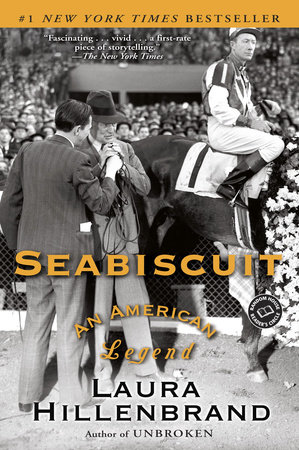Seabiscuit
An American Legend
Laura Hillenbrand
Ebook
Bestseller
July 1, 2003 | ISBN 9780345467393
AmazonApple BooksBarnes & NobleBooks A MillionGoogle Play StoreKobo
Paperback
Bestseller
March 26, 2002 | ISBN 9780449005613
AmazonBarnes & NobleBooks A MillionBookshop.orgHudson BooksellersPowell'sTargetWalmart
Hardcover
Bestseller
March 6, 2001 | ISBN 9780375502910
AmazonBarnes & NobleBooks A MillionBookshop.orgHudson BooksellersPowell'sTargetWalmart
About the Book
#1 NEW YORK TIMES BESTSELLER • From the author of the runaway phenomenon Unbroken comes a universal underdog story about the horse who came out of nowhere to become a legend.
Seabiscuit was one of the most electrifying and popular attractions in sports history and the single biggest newsmaker in the world in 1938, receiving more coverage than FDR, Hitler, or Mussolini. But his success was a surprise to the racing establishment, which had written off the crooked-legged racehorse with the sad tail. Three men changed Seabiscuit’s fortunes:
Charles Howard was a onetime bicycle repairman who introduced the automobile to the western United States and became an overnight millionaire. When he needed a trainer for his new racehorses, he hired Tom Smith, a mysterious mustang breaker from the Colorado plains. Smith urged Howard to buy Seabiscuit for a bargain-basement price, then hired as his jockey Red Pollard, a failed boxer who was blind in one eye, half-crippled, and prone to quoting passages from Ralph Waldo Emerson. Over four years, these unlikely partners survived a phenomenal run of bad fortune, conspiracy, and severe injury to transform Seabiscuit from a neurotic, pathologically indolent also-ran into an American sports icon.
Praise for Seabiscuit
“Fascinating . . . Vivid . . . A first-rate piece of storytelling, leaving us not only with a vivid portrait of a horse but a fascinating slice of American history as well.”—The New York Times
“Engrossing . . . Fast-moving . . . More than just a horse’s tale, because the humans who owned, trained, and rode Seabiscuit are equally fascinating. . . . [Laura Hillenbrand] shows an extraordinary talent for describing a horse race so vividly that the reader feels like the rider.”—Sports Illustrated
“REMARKABLE . . . MEMORABLE . . . JUST AS COMPELLING TODAY AS IT WAS IN 1938.”—The Washington Post
Seabiscuit was one of the most electrifying and popular attractions in sports history and the single biggest newsmaker in the world in 1938, receiving more coverage than FDR, Hitler, or Mussolini. But his success was a surprise to the racing establishment, which had written off the crooked-legged racehorse with the sad tail. Three men changed Seabiscuit’s fortunes:
Charles Howard was a onetime bicycle repairman who introduced the automobile to the western United States and became an overnight millionaire. When he needed a trainer for his new racehorses, he hired Tom Smith, a mysterious mustang breaker from the Colorado plains. Smith urged Howard to buy Seabiscuit for a bargain-basement price, then hired as his jockey Red Pollard, a failed boxer who was blind in one eye, half-crippled, and prone to quoting passages from Ralph Waldo Emerson. Over four years, these unlikely partners survived a phenomenal run of bad fortune, conspiracy, and severe injury to transform Seabiscuit from a neurotic, pathologically indolent also-ran into an American sports icon.
Praise for Seabiscuit
“Fascinating . . . Vivid . . . A first-rate piece of storytelling, leaving us not only with a vivid portrait of a horse but a fascinating slice of American history as well.”—The New York Times
“Engrossing . . . Fast-moving . . . More than just a horse’s tale, because the humans who owned, trained, and rode Seabiscuit are equally fascinating. . . . [Laura Hillenbrand] shows an extraordinary talent for describing a horse race so vividly that the reader feels like the rider.”—Sports Illustrated
“REMARKABLE . . . MEMORABLE . . . JUST AS COMPELLING TODAY AS IT WAS IN 1938.”—The Washington Post
Read more
Close




